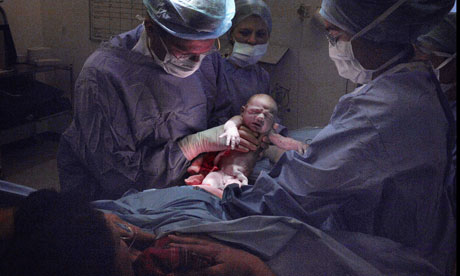
No woman who wants a caesarean should be refused one, but if women have the risks of surgery explained to them, the numbers should fall, according to fresh NHS guidance on childbirth.
The National Institute for Health and Clinical Excellence (Nice) has tried to deny speculation in the media that the new guidelines meant women would be entitled to a caesarean on demand, but the implication remains that nobody should be turned down.
Nice said most women would choose a vaginal delivery if they received proper information, and its guidelines committee said they did not recognise the concept of women choosing a caesarean because they were "too posh to push".
Most women who asked for a caesarean had either physical or mental health issues that made them unable or unwilling to try ordinary delivery, they said.
The phrase "too posh to push" was "something the media created", said committee member Nina Khazaezadeh, a consultant midwife at St Thomas' hospital.
Once women had a full discussion of the risks and benefits with health professionals, "they want to opt for the safest option. A lot of the anxiety is related to lack of information and lack of knowledge," she said.
Women may have the wrong impression from listening to friends and relatives or using the internet. "Communication is key to ensure we unravel these myths."
Around 25% of women give birth by caesarean in the UK, mostly because of an emergency. The rates vary across Europe from around 14% in the Nordic countries to 40% in Italy "according to obstetric practice," said Dr Gillian Leng, Nice's deputy chief executive.
The World Health Organisation, which used to say 15% of births by caesarean was enough, no longer makes a recommendation.
Changes to the current NHS guidance will bring the numbers down slightly, as women who are HIV positive – where modern drugs can suppress the virus so there is little risk to the baby at birth – will be allowed to have a vaginal birth. Women who have had two previous caesareans can now also be monitored and cared for better.
Malcolm Griffiths, a consultant obstetrician and gynaecologist at Luton and Dunstable hospital, who chaired the guidelines committee, said: "Caesarean section is major surgery. It is about as major as hysterectomy, after which you go home and do nothing for six weeks and some employers won't expect you back for six months. After a caesarean we send a lady home after two days and say 'here's a baby to look after as well'."
Some women have a fear of vaginal birth called tokophobia. Some have never had a baby, but others have suffered a traumatic experience during an earlier delivery.
These women put off getting pregnant, but when it happens, they have nightmares, said Khazaezadeh. "They can't concentrate on anything and are very anxious about the forthcoming birth and unable to function," she said.
Some women are so terrified they want to end the pregnancy. Griffiths said this was not uncommon. "A woman who had had two quite traumatic deliveries and couldn't cope requested an abortion," he said. "I said, how about a caesarean?" She accepted and was supported throughout the pregnancy. "At the end she had a normal vaginal delivery and was very happy," he said.
The revised guidelines were published as the Royal College of Midwives issued a report chronicling massive shortages of staff across Britain. England is worst hit, needing 5,000 more midwives to cope with a birth rate up 22% since 2001, or 10,000 more babies every month. Scotland needs 140 more, while Wales and Northern Ireland have an ageing workforce.
Lack of midwife support can contribute to a traumatic delivery and cause women to seek a caesarean next time, said Belinda Phipps, chief executive of the National Childbirth Trust. "Our services fail women badly at the moment … We hear from too many women who have found their experience traumatising in some way.
"If caesarean rates go up following the change to the guidelines, it will be evidence that women are not getting the quality of midwifery support they need to instil confidence and feelings of safety while giving birth."
Case study
Christine Johnson knew exactly how she wanted to deliver her first baby in 2002 – in a birthing pool at home. She practised sitting in it, but her due date came and went without any sign that the baby was ready to emerge.
Eventually she was admitted to hospital, given drugs to induce the birth three times without effect and found herself at the centre of a medical emergency. There was something wrong with the baby and an urgent caesarean was needed.
"It turned into one of the worst days of my life," she said. "There were so many awful things. The baby was seriously ill, in intensive care." She still cannot talk about it without tears. "When he was six hours old I had to ask the paediatrician if he was going to die. At 11 hours old I held him for the first time. It was awful."
The baby survived and is well, but Johnson says she got no emotional support for the trauma she had been through. "I tried to put it behind me. I didn't want to frighten friends." Then when she got pregnant again in 2006, she found she could not talk to the midwife for crying.
"I asked for an elective caesarean, which didn't go down well," she said. She had the irrational fear that once again she would not go into labour and felt it would be better to have a caesarean in case anything went wrong.
She had three sessions with a "brilliant" midwife counsellor, but she still wanted the caesarean – and got it. "I was so grateful I was allowed to have that experience, because it really made a huge difference. I have absolutely no regrets about the choice I made." She also understands other women might feel differently. "We are all individuals."

